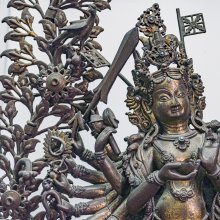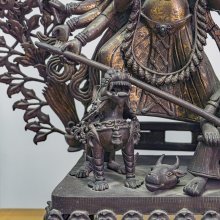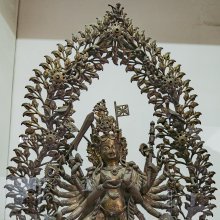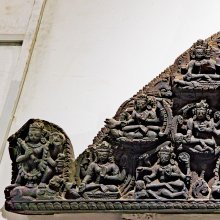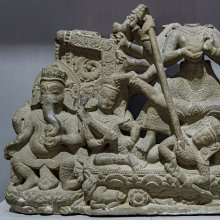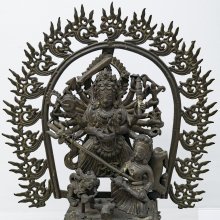Mahishasuramardini, Mahiṣāsuramardinī, Mahishasura-mardini: 5 definitions
Introduction:
Mahishasuramardini means something in Hinduism, Sanskrit. If you want to know the exact meaning, history, etymology or English translation of this term then check out the descriptions on this page. Add your comment or reference to a book if you want to contribute to this summary article.
The Sanskrit term Mahiṣāsuramardinī can be transliterated into English as Mahisasuramardini or Mahishasuramardini, using the IAST transliteration scheme (?).
Images (photo gallery)
(+21 more images available)
In Hinduism
Shilpashastra (iconography)
Source: Shodhganga: The significance of the mūla-beras (śilpa)Mahiṣāsuramardinī is the name of a deity depicted at the Nellaiappar Temple at Tirunelveli, representing a sacred place for the worship of Śiva.—Mahiṣāsuramardinī is represented with six pairs of hands. The right set of hands hold śūla (trident), khaḍga (sword), śakthāyuḍa (devi’s weapon), cakra (discus), a stringed bow, and gadā (mace) while the left hands hold pāśa, aṅkuśa, śaṅkh (shell), ghanṭa (bell), paraśu (axe) and shield. These pairs of hands are represented in kartarīmukha-hasta. While depiciting in dance, the hands are in kapittha-hasta and one pair of hands is in kartarīmukha-hasta.
Mahiṣāsuramardinī is also depicted at the Nellaiappar Temple at Tirunelveli, representing a sacred place for the worship of Śiva.—Mahiṣāsuramardinī is represented with six pairs of hands. The right set of hands hold śūla (trident), khaḍga (sword), śakthāyuḍa (devi’s weapon), cakra (discus), a stringed bow, and gadā (mace) while the left hands hold pāśa, aṅkuśa, śaṅkh (shell), ghanṭa (bell), paraśu (axe) and shield. These pairs of hands are represented in kartarīmukha-hasta. While depiciting in dance, the hands are in kapittha-hasta and one pair of hands is in kartarīmukha-hasta.

Shilpashastra (शिल्पशास्त्र, śilpaśāstra) represents the ancient Indian science (shastra) of creative arts (shilpa) such as sculpture, iconography and painting. Closely related to Vastushastra (architecture), they often share the same literature.
Shaktism (Shakta philosophy)
Source: Shodhganga: The significance of the mūla-beras (shaktism)Mahiṣāsuramardinī (महिषासुरमर्दिनी) refers to one of the manifestations of Pārvatī or Śakti.—While seeing the Śakti avatāra images namely Durgā and Mahiṣāsuramardinī, who are vigorous and ferocious in their forms and character, the perceiver gets scared of the weapons held in their hands. The most scaring gestures are the tongue projecting outwards, the skull in one hand, the kapāla with blood in one hand and the wide opened eyes with full of anger. But regardless of all this the perceiver admires the force with which the goddess fights for her devotees against the enemies who harass them. While depicting her in dance, so many variations can be brought in. The goddess is said to possess ten pairs of hands and each hand holds different weapons. So in sañcāribhāvas (improvisation of a particular sentiment or a story in various ways), all these characteristics can be very well brought out.

Shakta (शाक्त, śākta) or Shaktism (śāktism) represents a tradition of Hinduism where the Goddess (Devi) is revered and worshipped. Shakta literature includes a range of scriptures, including various Agamas and Tantras, although its roots may be traced back to the Vedas.
Languages of India and abroad
Sanskrit dictionary
Source: Cologne Digital Sanskrit Dictionaries: Monier-Williams Sanskrit-English DictionaryMahiṣāsuramardinī (महिषासुरमर्दिनी):—[=mahiṣāsura-mardinī] [from mahiṣāsura > mahiṣa > mah] f. = -ghātinī (dinī-stotra n. Name of a Stotra)
[Sanskrit to German]
Sanskrit, also spelled संस्कृतम् (saṃskṛtam), is an ancient language of India commonly seen as the grandmother of the Indo-European language family (even English!). Closely allied with Prakrit and Pali, Sanskrit is more exhaustive in both grammar and terms and has the most extensive collection of literature in the world, greatly surpassing its sister-languages Greek and Latin.
Kannada-English dictionary
Source: Alar: Kannada-English corpusMahiṣāsuramardini (ಮಹಿಷಾಸುರಮರ್ದಿನಿ):—[noun] (myth.) Cāmuṇḍi, who slew Mahiṣāsura a demon whose country is now known as Maisūru or Karnāṭaka.
Kannada is a Dravidian language (as opposed to the Indo-European language family) mainly spoken in the southwestern region of India.
See also (Relevant definitions)
Partial matches: Mahishasura, Mardini.
Starts with: Mahishasuramardinistotra.
Full-text: Mahishasuramardinistotra, Teramva, Parvati, Durga, Sonkh, Erudi, Tamasa, Unnamulai.
Relevant text
Search found 14 books and stories containing Mahishasuramardini, Mahiṣāsura-mardinī, Mahisasura-mardini, Mahiṣāsura-mardini, Mahiṣāsuramardinī, Mahisasuramardini, Mahiṣāsuramardini, Mahishasura-mardini; (plurals include: Mahishasuramardinis, mardinīs, mardinis, Mahiṣāsuramardinīs, Mahisasuramardinis, Mahiṣāsuramardinis). You can also click to the full overview containing English textual excerpts. Below are direct links for the most relevant articles:
Sripura (Archaeological Survey) (by Bikash Chandra Pradhan)
Ananda-Prabha-Kuti-Vihara < [Chapter 2 - The Architectural Panorama]
The Fortress < [Chapter 2 - The Architectural Panorama]
Padmapani Vihara (SRP-10) < [Chapter 2 - The Architectural Panorama]
Jainism in Odisha (Orissa) (by Ashis Ranjan Sahoo)
Jaina Antiquities in Jagatsinghpur District (Introduction) < [Chapter 3: Survey of Jaina Antiquities in Odisha]
Risabhanatha image in the PG. Deptt. of AIHC&A, Utkal University < [Chapter 3: Survey of Jaina Antiquities in Odisha]
Jaina Antiquities in Dandapalasa (Balasore) < [Chapter 3: Survey of Jaina Antiquities in Odisha]
Amaravati Art in the Context of Andhra Archaeology (by Sreyashi Ray chowdhuri)
Amarāvatī impact on later schools of Indian art < [Chapter 5 - Impact of Amarāvatī Art]
Pallava period (Social and Cultural History) (by S. Krishnamurthy)
Solid instruments (Ghana) < [Chapter 4 - Material Culture of the People]
Weapons and Warfare < [Chapter 4 - Material Culture of the People]
Dressing style of Women < [Chapter 4 - Material Culture of the People]
Middle Chola Temples (by S. R. Balasubrahmanyam)
Temples in Tiruppasur < [Chapter IV - Temples of Rajendra I’s Time]
Temples in Tirunelveli < [Chapter II - Temples of Rajaraja I’s Time]
The Central Shrine < [Tanjavur/Thanjavur (Rajarajesvaram temple)]
Varahi Tantra (English Study) (by Roberta Pamio)
Chapter 29 - The worship of Caṇḍikā < [Summary of the Vārāhī Tantra]
Related products
